
Maurits Cornelis Escher was a Dutch graphic artist who made mathematically inspired woodcuts, lithographs, and mezzotints. Despite wide popular interest, Escher was for most of his life neglected in the art world, even in his native Netherlands. He was 70 before a retrospective exhibition was held. In the late twentieth century, he became more widely appreciated, and in the twenty-first century he has been celebrated in exhibitions around the world.

The Penrose triangle, also known as the Penrose tribar, the impossible tribar, or the impossible triangle, is a triangular impossible object, an optical illusion consisting of an object which can be depicted in a perspective drawing, but cannot exist as a solid object. It was first created by the Swedish artist Oscar Reutersvärd in 1934. Independently from Reutersvärd, the triangle was devised and popularized in the 1950s by psychiatrist Lionel Penrose and his son, prominent Nobel Prize-winning mathematician Sir Roger Penrose, who described it as "impossibility in its purest form". It is featured prominently in the works of artist M. C. Escher, whose earlier depictions of impossible objects partly inspired it.
An impossible object is a type of optical illusion that consists of a two-dimensional figure which is instantly and naturally understood as representing a projection of a three-dimensional object. Impossible objects are of interest to psychologists, mathematicians and artists without falling entirely into any one discipline.
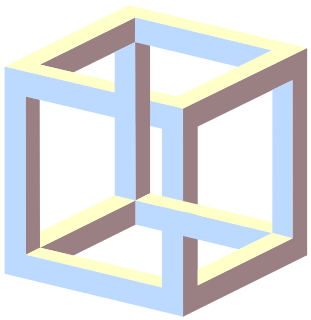
The impossible cube or irrational cube is an impossible object invented by M.C. Escher for his print Belvedere. It is a two-dimensional figure that superficially resembles a perspective drawing of a three-dimensional cube, with its features drawn inconsistently from the way they would appear in an actual cube.
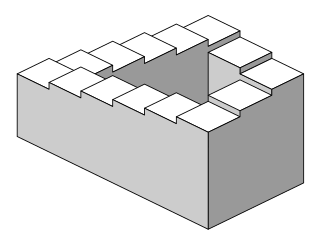
The Penrose stairs or Penrose steps, also dubbed the impossible staircase, is an impossible object created by Oscar Reutersvärd in 1937 and later independently discovered and made popular by Lionel Penrose and his son Roger Penrose. A variation on the Penrose triangle, it is a two-dimensional depiction of a staircase in which the stairs make four 90-degree turns as they ascend or descend yet form a continuous loop, so that a person could climb them forever and never get any higher. This is clearly impossible in three-dimensional Euclidean geometry but possible in some non-eucliean geometry like in nil geometry.

Reptiles is a lithograph print by the Dutch artist M. C. Escher first printed in March 1943. It touches on the theme found in much of his work of mathematics in art.

Another World II, also known as Other World II, is a woodcut print by the Dutch artist M. C. Escher first printed in January 1947.

Convex and Concave is a lithograph print by the Dutch artist M. C. Escher, first printed in March 1955.
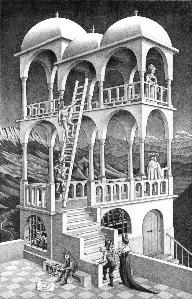
Belvedere is a lithograph print by the Dutch artist M. C. Escher, first printed in May 1958. It shows a plausible-looking belvedere building that is an impossible object, modelled after an impossible cube.
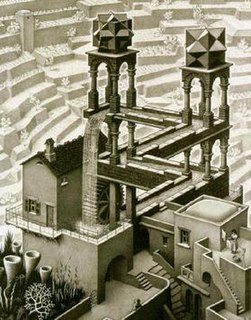
Waterfall is a lithograph by the Dutch artist M. C. Escher, first printed in October 1961. It shows a perpetual motion machine where water from the base of a waterfall appears to run downhill along the water path before reaching the top of the waterfall.

Oscar Reutersvärd was a Swedish graphic artist, who in 1934 pioneered the art of 3D drawings that may initially appear feasible, yet cannot be physically constructed. He is sometimes described as "the father of the impossible figure", although there are much older examples, e.g. Hogarth's Satire on False Perspective.
Castrovalva is the first serial of the 19th season of the British science fiction television series Doctor Who, which was first broadcast in four twice-weekly parts on BBC1 from 4 to 12 January 1982. It was the first full serial to feature Peter Davison as the Fifth Doctor. The title is a reference to the lithograph Castrovalva by M. C. Escher, which depicts the town Castrovalva in the Abruzzo region, Italy.
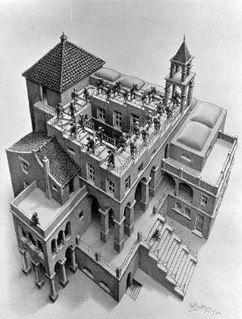
Ascending and Descending is a lithograph print by the Dutch artist M. C. Escher first printed in March 1960.
There are numerous references to Dutch painter M.C. Escher in popular culture.

Cube with Magic Ribbons is a lithograph print by the Dutch artist M. C. Escher first printed in 1957. It depicts two interlocking bands wrapped around the frame of a Necker cube. The bands have what Escher called small "nodules" or "buttonlike protuberances" that make use of the dome/crater illusion, an optical illusion characterized by shifting perception of depth from concave to convex depending on direction of light and shadow. Escher's interest in reversible perspectives, as seen in Cube with Magic Ribbons, can also be noted in an earlier work, Convex and Concave, first printed in 1955.

Mathematics and art are related in a variety of ways. Mathematics has itself been described as an art motivated by beauty. Mathematics can be discerned in arts such as music, dance, painting, architecture, sculpture, and textiles. This article focuses, however, on mathematics in the visual arts.

Print Gallery is a lithograph printed in 1956 by the Dutch artist M. C. Escher. It depicts a man in a gallery viewing a print of a seaport, and among the buildings in the seaport is the very gallery in which he is standing, making use of the Droste effect with visual recursion. The lithograph has attracted discussion in both mathematical and artistic contexts. Escher considered Print Gallery to be among the best of his works.

Still Life with Mirror is a lithograph by the Dutch artist M. C. Escher which was created in 1934. The reflection of the mirror mingles together two completely unrelated spaces and introduces the outside world of the small town narrow street in Abruzzi, Villalago, into internal world of the bedroom. This work of Escher is closely related to his later application of mirror effect in 1937 Still Life and Street. Escher manipulates the scale in different parts of the print to achieve the effect of smooth connection between worlds.

Dragon is a wood engraving print created by Dutch artist M. C. Escher in April 1952, depicting a folded paper dragon perched on a pile of crystals. It is part of a sequence of images by Escher depicting objects of ambiguous dimension, including also Three Spheres I, Doric Columns, Drawing Hands and Print Gallery.
Day and Night is a woodcut made by the Dutch artist M. C. Escher in 1938.
















